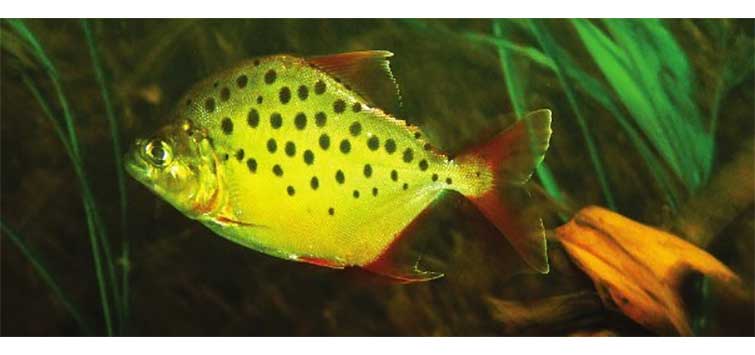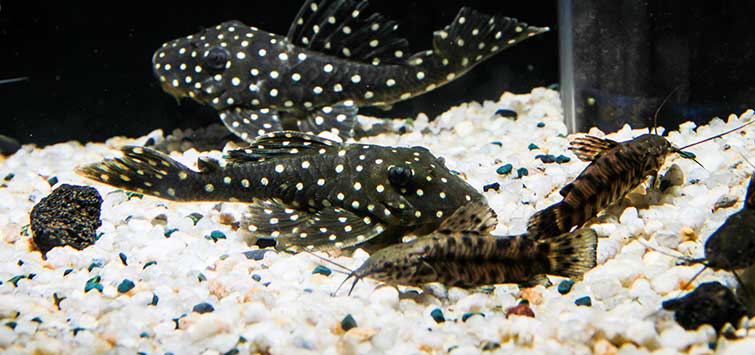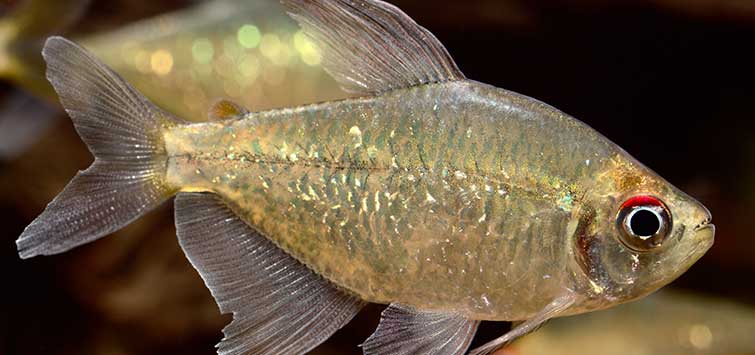A TFH Exclusive: The First Live Pictures of Pristobrycon careospinus
Author: Ivan Mikolji
TFH is proud to present the first and only known photographs of a living Pristobrycon careospinus! Follow the author on his journey through a thick veil of horseflies and into the jungle darkness to track down this elusive Venezuelan piranha.
Learning About Piranhas
After fishing and swimming in many rivers across Venezuela, I was surprised to find that many of them contained piranhas. Each geographical area I visited had housed different species that I could not identify, so I decided to ask two piranha people I was familiar with, George Fear and Frank Magallanes. After exchanging pictures via email, Frank told me to ask Antonio Machado-Allison for more information. Antonio is the biologist who had described and worked with many of the South American species, and is one of the world’s experts in piranhas. So, off I went to the Central University of Venezuela (or UCV, for its Spanish name Universidad Central de Venezuela)—to meet Machado.
Piranha 101
After getting acquainted, he gave me a tour of his lab, a copy of his piranha book Los Peces Caribes de Venezuela, and took the time to teach me a few things involving piranhas.
There are 13 species of piranhas described for Venezuela. They all belong to the subfamily Serrasalminae, and the 13 species are categorized within four genera: Pygopristis, Pristobrycon, Pygocentrus, and Serrasalmus. The first two genera include piranhas whose diets alternate between meat and fruits; the other two are mostly carnivorous, only including fruits in their diets when there is an extreme lack of prey. The protein component of the piranha diet consists mostly of fish scales, fish fins, whole fish, and, in special cases, animal carcasses. Most of the animals that piranhas feed upon consist of aquatic fauna that have either died or are too sick or too old to escape down the river before they are bitten and eaten.
After reading Machado’s book, I noticed that there was a species that had never been photographed alive before—Pristobrycon careospinus.
Aquatic Phantoms
Pristobrycon careospinus is a piranha that Machado had described with William Fink in 1992. The scientific work used to describe the species reads: “Live Coloration pattern: There is no information about the live coloration of this species. The only specimen of this fish available was captured some time ago, and no description of the live pattern exists.” The preserved coloration pattern was available, however: “Alcohol Coloration pattern: The body is covered by irregularly placed oval spots having few below the lateral line.” The scientific work also points out the limited scope of the species’ description, along with a few physical traits: “Discussion: This species has been described based on only one specimen from the Atabapo River in the Amazon State in Venezuela. The specimen apparently is a pre-adult adolescent. The species shares with other members of this genera (P. striolatus and P. maculipinnis) the primitive condition of lacking a pre-anal spine, but it differs from them in the oval spots’ coloration pattern.”
A Photographic Expedition
A year later, I met with Machado again and told him that I was interested in trying to shoot the first live pictures of P. careospinus. Machado took me into the UCV biological museum where the preserved holotype was located. He took it out of the jar so I could take pictures of it for field reference. Being there with the describer of the fish (and being able to take pictures of a holotype of a fish that had never been seen alive) made me eager to arrange an expedition to photograph this rare piranha.
Since I knew its locality and could recognize its particular body shape and identifying marks (oval spots on the upper part of the body), I believed that there was enough information for me to go out into the field and photograph a living specimen of this piranha for the first time ever.
The Long Journey
I set off on an expedition to look for P. careospinus, beginning my trip in the northern city of Valencia, Venezuela. The road trip to the northern part of the Venezuelan Amazonas State took me about 12 hours. I stopped only for restroom breaks, sodas, and to stretch my legs as I waited for my car to get on a barge (referred to locally as a chalanas) so I could cross the Cinaruco and Orinoco Rivers. This is a very remote area, so the rivers had no bridges over them.
When I arrived in the Amazonas State, I contacted my good friend and local expert fish collector, Alipio, who arranged a four-hour boat trip south to the Atabapo River. The next day we drove an hour south to the town of Samariapo and got on a boat equipped with two 150-hp outboard motors. We traveled at 90 kph (55 mph) down the Orinoco River to the town of San Fernando de Atabapo, which is located on a triangular tip of land. There are three rivers that merge at this point. On the south is the Atabapo River, on the north is the Orinoco River, and to the west are the Guaviare River and the Colombian shore.
Day 1: Local Skepticism
As we walked around the small town through heavy rain showers, we asked the locals if they had seen P. careospinus, showing them the pictures of the holotype and reading the scientific description from Machado’s book. The local people all said that the careospinus is locally called maripano. We asked them where we could fish it, and they all came up with the same answer. “Come back in the dry season—at this time of the year (the rainy season), it’s impossible to fish one.” Alipio and I were very overwhelmed to hear the same answer over and over, and decided to try for one for a couple of days—if no specimens were found by the fourth day, we would abort the mission.
Day 2: Scouting
We woke up early in the morning and went to the dock where all the fishermen come to sell the fish they catch. For two or three hours, we inspected all the fish that each fishing boat brought in, but we only saw one species of piranha over and over again. It was the large Serrasalmus rhombeus, which are commonly called black rhoms in the aquarium trade. We decided to contract one of the only five trucks that exist in the town to take us to a clear river that was an hour away on a dirt road. Our thoughts were to swim one mile up the river every day to see if we could spot the careospinus or any other type of piranha.
We got all our gear on the flatbed truck and drove one hour inland to the river. At the river, we were overwhelmed by the small river’s water levels—they were very high because of heavy rains that flooded the whole jungle, and we were actually able to swim in between the tree trunks! The banks and bed of the river consisted of pure white silica sand. After seven hours of swimming, we found no trace of any piranha and went back into town on top of the flatbed, under pouring rain.
Day 3: Hypothermia, Horseflies, and Pitch-Black Jungle
Again, we woke up early in the morning and went to the dock to inspect the catches of the day, only to find large amounts of Serrasalmus rhombeus. I was starting to get a little desperate, so I offered the fishermen a reward for any careospinus and took the flatbed truck out again to the clear river. The outside temperature in the rainy season was 29°C (84°F) and the water temperature was 24°C (75°F). After more than four hours in the water, we started shivering involuntarily because of hypothermia. Sometimes the rain stopped for an hour or so, and we quickly got out of the cold water to get warmed by the sunlight—but as soon as we got out, we were attacked by gnats and horseflies. There were actually so many horseflies that for pure entertainment, we started placing all the ones we swatted in an old tin can. On some days, we’d have nearly 40 flies packed into it!
Our plan was to snorkel at night, thinking we had a better chance of spotting the careospinus if it was asleep. At 6:30 p.m. it was already pitch black, but we decided to wait at least one hour to make sure that the fish had fallen asleep. The hour went by very slowly—time appears to slow to a crawl when you are in absolute darkness in the middle of a jungle. I had never heard so many frogs and toads singing at such a high volume at a single time. We spent an hour listening to an out-of-tune orchestra, with all the wildlife playing their own melodies and no director to guide them. At 7:30 p.m., we equipped ourselves with flashlights and finally entered the water. The wildlife’s transition from diurnal to nocturnal became instantly obvious. There were dozens of knifefishes, catfish, plecos, wolf fish, rays, and crustaceans feeding and swimming around. We inspected the river until our truck arrived at 9:00 p.m. The day was interesting, but unfortunately we still found no trace of any piranha.
Day 4: Contact
We woke up and walked to the dock—once again, there were only Serrasalmus rhombeus. Our reward had not worked either, with every fisherman telling us to come back in the dry season. Again, we took our truck back to the river. After swimming for a couple of hours in the cold water, Alipio and I sat down on the white sand riverbank and tried to make a plan. We decided that he would swim upstream and I would swim downstream. If one of us spotted a piranha, we would scream out loud at the top of our lungs so we could hear one another through the jungle.
I had a 14-pound lead belt on my waist, making it impossible for me to swim, so I had to bounce or jump to the surface for air in the deeper areas of the river. I was not even a hundred yards down river when I heard Alipio screaming “Piranha! Piranha!” As I jumped my way up the river, I thought that Alipio must have spotted a silver dollar Metynnis, Mylossoma, Myloplus, or Myleus, and thought that it was a piranha. After what seemed like an eternity in fighting and jumping against the current, I saw Alipio, who repeated that there was something down in the deep end that resembled a piranha.
I bounced my way over to him and finally managed to reach his location, but the current was so strong in the deep end that I had to find a tree branch without thorns and secure myself with it. I then took a deep breath and sank 6 to 8 feet underwater with Alipio, where he pointed out a golden, shiny fish far off in the jungle brush. Coming up for air, we decided to try to get through this jungle so we could get closer to the piranha. We both advanced, trying to push ourselves through the tangled vines and branches with water up to our necks.
I had only advanced 2 or 3 feet until I realized that my sides were full of large, one-inch thorns! I looked at Alipio, who was busy picking thorns off the top of his head. We decided it’d be a better idea to see if the piranha would swim out of the thorny, tangled vines towards us. The trees above made a perfect vault, so there was no direct sunlight coming in and we were shivering uncontrollably. On top of that, the water’s strong current made us even colder. It was a significant contrast from the slower and calmer areas of the river. At that moment, there were at least six horseflies buzzing over our heads, and it was a relief to drop underwater and drown out their buzzing as we continued to look for the piranha.
I took a look around and spotted a large moriche palm trunk that I was able to jump to and grapple with my legs. This not only prevented me from being dragged by the current, but it freed my hands so I could hold my camera. As I sank down and took another look from my new location, I saw the piranha right in front of me. It actually stopped for two or three seconds—just enough time for me to take a picture—then went back into its tangled hideout. Luckily, it came out of hiding five or six times, so I got a couple of pictures, but eventually it disappeared back into the flooded jungle.
A Rare Encounter
We spent the next two days trying to find the piranha in the same spot, but were unsuccessful. We even tried tying different types of bait to the sunken tree branches in order to attract it, but the fish was never seen again.
After I returned from the expedition, I went to the UCV to show Antonio Machado my pictures. As I went through the pictures, he had a great smile on his face. I asked him if the pictures contained the Pristobrycon careospinus. “In so many years of working with piranhas, one thing that I have learned to do well is to identify piranhas by pictures, and this is unmistakably a Pristobrycon careospinus.” The positive identification of my findings from the expert biologist Dr. Antonio Machado-Allison is certainly one of the things that will keep me investigating the rivers of Venezuela for some time to come.
The pictures accompanying this article are those very photos—the very first live photographs of this species!
See the full article on TFH Digital http://www.tfhdigital.com/tfh/200811/#pg73

.png?h=595&iar=0&w=2781&hash=5FD5E69473BCC22199FBFA2FB71B6033)



